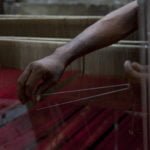Men and women. Whole families really. A complex web of professions. A mix of castes. The weaving ecosystem epitomises India.
For example, in Gujarat, the weavers of the Hindu Khatri community used to weave the kinkhabs or fabric of dreams. Kinkhwab is a Persian word. The weaves had gold and silver threads and were used by royalty.
In Gujarat today, a mix of Muslim and Hindu artisans work together to create myriad weaves.



Barefoot, he wears a simple lungi with Madras checks and creates a beautiful brocade
What makes the Ashavali weave special?
It was the original brocade. Connected to the courtly fabrics of Persia and the Mughal empire.
Motifs include the following:
- Floral vines
- Paisleys
- Parrots
- Peacocks
- Moon
- Swastika
- Human figures
- Dancers
- Various flowers
- Mango
Embellishing the fabric
Soft, layered embellishments. Very Mughal in style. The dense outlines which gave a “relief work” look to the fabric was called minakari. Almost like inlay work in jewellery. A charactistic of the Ashavali brocades.

Two artisans work on a weave 

The backside reveals a complex web of designs
The Great Migration
Ashavali weavers migrated to Benaras, Delhi, and South India.
A few weavers from Ashaval migrated to nearby villages Ridrol and Nardipur. But the traditional textile designs and weaves were hard to sustain. After independence, many of the traditional muslim clients who used these brocades migrated to Pakistan leading to decline in demand of brocades.
Today a small cluster in Ridrol still continues the tradition of the grand Ashavali weaves.













